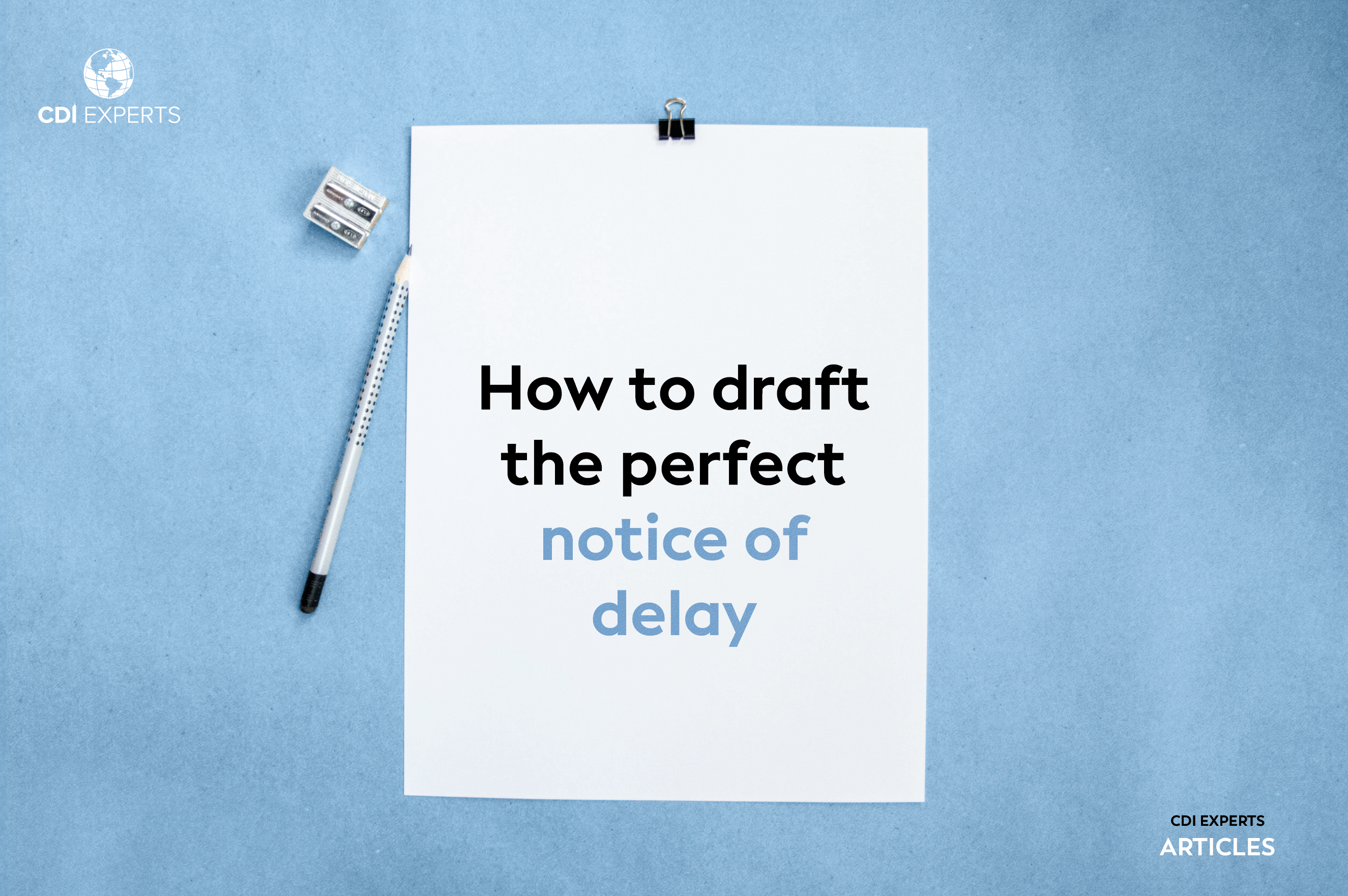Written by
Alexander Tuhtan
Published
30 Jan 2023
Aside from usually being a precondition to any extension of time (EOT), a notice of delay is often helpful in resolving disputes early on.
Construction contracts deal primarily with three things – costs, time and risk allocation.
It’s pretty obvious from a plain reading of a construction contract how it deals with time. Usually one part will specify when the works are required to be completed by and another part will set out how the date for completion can be changed.
Construction contracts are, however, more subtle as to how they manage risk. One of the biggest risks for any project is the amount of time that it takes to complete the works.
There are many factors which can affect the timing of the works, such as inclement weather, latent conditions, changes in legislative requirements or design changes.
All well drawn contracts clearly assign the risk of each type of event onto either the contractor or the principal. For example, if works carried out as a result of a latent condition do not entitle the contractor to claim an extension of time, then that risk falls on the contractor.
Good builders and principals deal with time related risks primarily in three ways.

First, they build contingency or ‘float’ into the time estimated to complete the project. That way if there is a delay, it is within the boundaries of what is acceptable to make the project profitable.
Second, they ensure that as much risk as possible is passed down the chain to subcontractors. Over the past 20 years, the risk expected to be taken on by subcontractors has increased significantly. Take civil works for example. In years gone by, every civil subcontract contained a carve out which allowed the subcontractor to claim additional costs for excavating rock compared to soil or other material. These days, with advances in technology and an increasingly competitive market, it is not uncommon for some civil subcontractors to take on the risk of excavating rock entirely.
Third, and most importantly, modern contracts contain mechanisms which force the contractor to provide ‘early warning’ notices of any potential change in time or cost swiftly. If these notices are not provided, then the contractor often risks losing its entitlement to claim extra time or costs altogether.
These early warning mechanisms are designed to allow the principal to become involved in an issue early on and hopefully work with the contractor to resolve the issue with minimal changes to the original budgeted time and cost for the project.
The main notice in the early warning system for time related changes is the notice of delay.
An invalid EOT can result in disaster for a contractor. This is because, failing to secure an EOT can result in a ‘double loss’ for a contractor by not only being liable for liquidated damages, but also losing their entitlement to claim delay costs.
Whilst failing to secure an EOT can result in a double loss, failing to serve a notice of delay can perhaps result in a third loss – being the opportunity to resolve a dispute early.
Often overlooked and ignored, the notice of delay serves a dual purpose in:
1. Serving as a precondition for the contractor being entitled to claim an EOT (or in more simple terms, a hurdle that must be overcome before the contractor is entitled to claim an extension of time).
2. Giving the principal the opportunity to investigate the delay and adjust accordingly. If the principal is a head contractor, this means preparing and gathering its evidence for a claim up the chain. If the principal is a developer or owner of the project, it gives them the opportunity to refinance or adjust the price for the development.

In Multiplex Constructions (UK) Limited v Honeywell Control Systems Limited (No. 2) [2007] EWHC 447, Justice Jackson described the purpose of notices of delay as follows:
“Contractual terms requiring a contractor to give prompt notice of delay serve a valuable purpose; such notice enables matters to be investigated while they are still current. Furthermore, such notice sometimes gives the employer the opportunity to withdraw instructions when the financial consequences become apparent.
Delays can sometimes last for long period of time and it is not often clear when it will end. When a prolonged delay occurs, it can be unfair for the principal to only find out about it at the end (rather than the start) when it may have the opportunity to issue a direction which might minimise the delay altogether.”
Also, a well-drawn notice of delay can often be used as a ‘trial run’ or checklist of issues to be addressed in any other claims such as EOTs.
And herein lies the utility of the notice of delay – it is the first opportunity to avoid a dispute. This is because, a well-drawn notice of delay informs the head contractor of a potential delay, identifies the facts underlying a potential delay and gives the principal an opportunity to investigate and mitigate the effects of the delay.
A notice of delay, however, is not a claim in itself. It is merely a notice to the principal that a delay may occur to any part of the works. Given that it’s not a claim, it is all too often ignored – forcing the parties into dispute when an EOT is finally claimed and it’s too late for the principal to properly investigate whether the EOT should be granted. When this occurs, the principal has no option but to resist the claim or risk losing money on the job.
Below, I set out how to prepare the perfect notice of delay that will not only secure your claims but also, help avoid any dispute before it begins.
Step no. 1 – identify whether a notice of delay is required under the contract
There is no requirement for a contractor to provide any notice of delay outside that which exists in the contract. Most standard form contracts require the contractor to provide a notice of any delay to the works.
Crucially, a notice of delay is usually required to be given for ANY delay to the works, rather than a delay that affects the date for completion.
For example, the Australian Standard Administration Manual provides:
“The notice of delay by the Contractor or the Principal must be given under subclause 34.2 whether or not the party giving the notice believes there will be delay to practical completion as the obligation to notify arises when the party believes that there will probably be a delay to WUC, not whether the party believes practical completion may be delayed.”
In other words, if a contract requires the contractor to serve notices of delay, then they are technically required to provide notice every time there is an event which delays the works – even if the delay doesn’t affect the date for completion. No doubt, this requirement can result in a lot of paperwork being generated, so it is not uncommon under some contracts for there to be no requirement to serve a notice of delay at all.
If there is no requirement to provide a notice of delay, then there is no need to do so. Some contracts merely require the contractor to make an extension of time claim in the event of any delay.
That being said, there is often still merit in providing a notice of delay for the reasons set out above. Should you decide to serve a notice of delay under a contract where you’re under no requirement to do so, then make sure that it’s clear the notice of delay is not your EOT claim.
This is because, most contracts specify exactly what information has to be provided in an EOT claim, which are unlikely to be able to be dealt with in a notice of delay.

Step no. 2 – identify the timing requirements for any notice of delay
Strict contracts usually make the contractor jump through certain ‘hoops’ before they’re entitled to claim a variation or extension of time.
For extension of time claims, the notice of delay is the first hoop – usually making the notice of delay a precondition for the contractor being entitled to claim an extension of time.
In other words, under a tight contract – no notice of delay, no EOT.
Ultimately, the timing requirements for any notice of delay will be unique to each contract.
Under AS2124 and AS4000 series contracts (AS4000, 4901, 4902, 4903, 4905, 4906 etc.), any notice of delay must be given ‘promptly’. There is no consequence stated in the contract for a failure to provide the notice.
That being said, it is important to note that if the Contractor wishes to claim an EOT under AS2124, then it must do so within 28 days pursuant to clause 35.5. It impossible to claim an extension of delay without first providing a notice of delay, or at least, providing enough details in the extension of time claim to satisfy the requirements for a notice of delay.
Under the AS4000 series contracts, clause 41.2 specifically provides that there is no penalty for failing to comply with part of a subcontract, other than entitling the other party to sue for damages.
Clause 41.2 is extracted in full below:
“Liability for failure to communicate
The failure of a party to comply with the provisions of subclause 41.1 or to communicate a claim in accordance with the relevant provision of the Subcontract shall, inter alia, entitle the other party to damages for breach of the Subcontract but shall neither bar nor invalidate the claim.”
In other words, clause 41.2 is a “get out of jail free card” for contractors who are late in serving their EOT claims.
As a general rule, notices of delay should be provided as soon as the delay event occurs – even if the end date of the delay is unknown. This is because, most contracts require that a notice be given within a certain amount of time from the delay commencing.
On the other hand, there is rarely any penalty for failing to provide a notice of delay.
A little-known fact is that under both the AS2124 and AS4000 series contracts, both the contractor AND the principal are required to notify the superintendent of any probable delay. Unfortunately, there are usually few remedies available to the contractor if the principal fails to provide a notice of delay.

Step no. 3 – identify the issues to be addressed by the notice of dispute (and if in doubt, use the below)
The requirements for a valid notice of delay are usually much less onerous than those for an extension of time.
For example, Form PC102 from the Australian Standards 4000 series contracts Administration Manual simply prompts the contractor to provide the most basic information about the causes of the delay. Below is the key content of the form:
“The Contractor notifies the Principal and Superintendent that there will probably be delay to WUC because of:
[insert causes of delay] ………………..
It is estimated that the delay to WUC will be for [insert days].”
Whilst the above may satisfy Australian Standards contracts, it is likely to fall well short of bespoke contracts. These contracts usually have much more stringent requirements – in part because the notice of delay clause is linked to a time bar so that if it is not strictly complied with, then the contractor loses its entitlement to claim.
Each contract will contain its own unique preconditions for a valid notice of delay, however, addressing the below issues in your notice of delay should satisfy the requirements of the vast majority (and most onerous) of bespoke contracts:
- a background, chronology or overview of the facts which explain the likely delay;
- details of the delay or potential delay, including its cause;
- how the delay or potential delay will affect the progress of any works;
- the measures which are available to overcome the delay or potential delay (if any);
- the measures which are in fact being taken to overcome the delay or potential delay (if any);
- the start date or estimated start date of the delay;
- the end date or estimated end date of the delay (or if the end date cannot be predicted, an explanation as to why it cannot be predicated and an explanation as to why events need to take place for the delay to end);
- an estimate of the total days that the date for completion will be delayed (this can be set out in working days, calendar days or even hours);
- an explanation of which items on the program or key works will be delayed and why those works are critical to achieving completion;
- any evidence that the contractor intends to rely upon in proving the delay;
- if the date for completion is affected by the delay, what is the current date for completion (and provide a program showing the works necessary to achieve that date);
- if the date for completion is affected by the delay, what is the anticipated new date for completion (and provide a new program showing the works necessary to achieve that date).
Whilst the above may seem like overkill – the above checklist is really a ‘belts and braces approach’ that is designed to be sufficient in even the strictest of contracts. Notwithstanding, all of the above issues can usually be dealt with in a page or two.
If the delay is obvious and there are no specific issues that have to be dealt with under the contract in any notice of delay then a simple one line email will often suffice.

Concluding thoughts.
A notice of delay is not a claim, it is usually merely a notice from the contractor to the principal that a delay may occur to the work.
It is therefore often ignored as being unnecessary or simply forgotten – which is a dangerous approach.
This is ironic as the notice of delay is the ‘first line of defence’ for a contractor when a project is likely to be disrupted. Depending on the terms of the contract, failing to serve a notice of delay often results in any subsequent EOT being time barred. To make matters worse, the contractor also loses a valuable opportunity to avoid a dispute entirely had the principal been made aware of the potential delay early on.
Often, delays can be avoided with a joint effort between the Principal and the Contractor. The burden, however, lies on the Contractor to manage these issues to make this happen.
Most modern construction contracts are drafted clearly with the intention that the notice of dispute is a ‘early warning mechanism’ for delays. This process in practice is designed to force both parties to communicate and to try and minimise any delays to the project. Amazingly, many contractors see notices of delay as a procedural burden – rather than their key to success in any delay related claims.
Written by Alex Tuhtan
References:
Tuhtan, A. (2021, January 15). How to draft the perfect notice of delay (and why they’re a lot more important than you think). LinkedIn. Retrieved from http://www.linkedin.com/pulse/how-draft-perfect-notice-delay-why-theyre-lot-more-important-tuhtan/
Follow us for more!
Get the expert edge
Please add your details below and we’ll be in touch as quickly as possible





